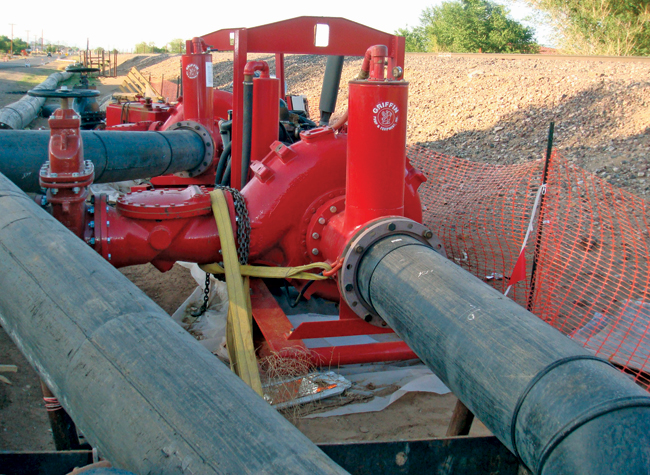Bypass Surgery
When a vital artery bursts, swift action is needed to stabilize the situation. Water and sewer lines that flow beneath our cities are not unlike the body’s life veins, and when they rupture experts like Griffin Dewatering Corp. swoop in to perform instant triage.

Griffin was called by TLC Plumbing in April while working on a project in Albuquerque, N.M., to look at a site where a 54-in. sewer line had collapsed. The collapse had resulted in a major intersection in Albuquerque to be closed and sewage to overflow. TLC had worked to contain the situation, but in order to make the repairs realized, bypass pumping would be required.
The sewer line that had collapsed was a reinforced concrete pipe that had been corroded by hydrogen-sulfide. As a result, other areas of the pipe were weakened. Additional potential collapse areas were evident along the line. This made it critical to maintain the flow on the existing pipe because any surges on the line could cause the pipe to collapse. The pumps would be required to pump approximately 7,000 gpm while operating at an 18-ft suction lift with minimal head pressure. The 18NCRD pump was a good fit for the application.
Griffin had an additional 18NCRD pump in Albuquerque that was available for use on the emergency project site. However, the challenge was being able to find piping in order to complete the discharge line. With the assistance from TLC, 18-in. HDPE pipe was found locally in Albuquerque. Griffin was able to utilize the assistance of local HDPE supplier, SECOR, to fuse the suction and discharge lines required for the project.
Griffin had first visited the site at 12:30 p.m. and upon notice to proceed began to mobilize the equipment to the site. The setup on the bypass and fusing of the pipe began by 5 p.m. At midnight, the discharge line was completed. By 3:30 a.m., the suction and the pump were set up and the pumps started.
The next morning, the excavation was dry enough and digging could begin to prepare for the sliplining operation. Traffic was opened to one lane through the intersection. However, due to the critical nature of the bypass operation, TLC requested Griffin to determine how a stand-by or secondary pump could be put in line as well. Griffin analyzed the materials available and informed TLC that they could use one of the pumps from another project site and bring an additional pump from Houston. Griffin also informed TLC that if it could assist in finding a flanged tee, the second pump could be added to the existing discharge line. A tee was found and gate valves were added in line so that either pump could be isolated.

Due to peak flow conditions, the secondary pump had to be tied into the discharge line in the early morning at 6 a.m. This was accomplished in about two hours, but the suction line had to be installed by breaking into the top of the pipe. Because peak flow was getting close, this was done the following morning at 4 a.m.
During the initial startup, the primary pump was able to pull up two 10-in. diameter chunks of concrete from where the ring and cover were removed from the manhole right into the eye of the impeller. The suction line had to be disconnected so that the debris could be removed because the debris was larger than the clean-outs could accommodate. After cleaning those seriously clogged arteries, TLC Plumbing was able to restore the aging and deteriorating sewer line.
Thomas Aldridge is a sales engineer for Griffin Dewatering Corp., based in Houston.

Comments are closed here.